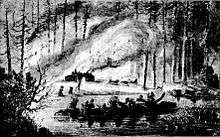Saguenay Fire
Saguenay Fire was a forest fire in Saguenay–Lac-Saint-Jean area, Quebec, Canada, on Wednesday, May 18, 1870, which lasted for one day.[1][2][3] It was one of the largest fires in the region.[4] It burned a total area of 4,000 square kilometers (0.4 million hectares).[2][5][6][7] Seven people were killed, many were injured, and hundreds of families lost everything they owned.[1][2][6][8] It generated high-level smoke, which was visible from Ireland, Britain, and western mainland Europe.[2]
| Saguenay Fire | |
|---|---|
| Location | Saguenay–Lac-Saint-Jean, Quebec, Canada |
| Statistics | |
| Burned area | 988,421 acres (400,000 ha) |
| Cause | Brush fire land clearing spread by felled dry trees and strong winds. |
Origin
The settlers in this region were clearing the land with brush fires. The controlled burn turned into a massive forest fire due to dry conditions, which was further fueled by felled trees and strong winds.[2][9][5][3]
Description

The wildfire spread rapidly, and in a few hours, it burned everything in the 150-kilometer region.[9][3][7][8] Residents of the area did not get time to gather their valuables and were forced to take refuge in the nearest area of water. Seven people died in the fire, and one-third of the entire Saguenay region population lost their homes and valuable possessions. By May 19, the fire burnt itself out.[2][9][10]
Optical Effects
The wildfire gave rise to unusual optical effects on 22nd and 23rd May 1870. The ‘strange’ appearance of the sun and sky was widely observed in Ireland and a few parts of British Isles.[2][11]
Consequences
Agriculture in the area was severely impacted. More than 500 farming families lost everything.[2][7] The fire lasted for one day, but a huge plume of smoke particles propagated towards the east due to the upper winds.
Benefits
The fire destroyed hundreds of miles of forests along its shores. The fire cleared the land for farming and opened up the Lac St.-Jean area. The fields after the fire were ready to be cultivated. It attracted many farmers. The fire helped in the growth of blueberries. Berry-picking has become a popular tourist activity in the region..[12][13]
References
- "Fire Disasters | The Canadian Encyclopedia". www.thecanadianencyclopedia.ca. Retrieved 2020-04-15.
- "The Diary of John Oram – West Moors Miscellany". Retrieved 2020-04-15.
- "Mother Nature: 10 Episodes of Wild Weather". Canadian History. Retrieved 2020-04-15.
- "Canada's burning question". HazNet. 2018-05-25. Retrieved 2020-04-15.
- Alexander, Martin E. "‘Lest we forget’: Canada’s major wildland fire disasters of the past, 1825-1938". International Association of Wildland Fire. Retrieved 2020-04-15.
- "Card accompanying the scholarship, awarded to Miss Newcomb from Villa Maria boarding school, to be given the victims of the Saguenay Fire". Faith in Action. Retrieved 2020-04-15.
- Saguenay–Lac-Saint-Jean. "Quebec History: Key Events in Saguenay-Lac-Saint-Jean". Monsaglac. Retrieved 2020-04-15.
- "Big Canadian Forest Fires Past to Present – Brandon Pullan REALTOR® at RE/Max Alpine Realty". Retrieved 2020-04-15.
- "The most devastating forest fires in Canadian history". Cottage Life. 2014-07-17. Retrieved 2020-04-15.
- "The Deadliest Fires in Canadian History". WorldAtlas. Retrieved 2020-04-15.
- "AstroArchaeology on the Internet". New London, CT Patch. 2012-09-14. Retrieved 2020-04-15.
- Ouellet, Danny (2018-09-28). "Berry picking | Tourisme Alma Lac-Saint-Jean". tourismealma.com. Retrieved 2020-04-15.
- "The industry | The "Superfruit" | Délices du lac". delicesdulac.com. Retrieved 2020-04-15.